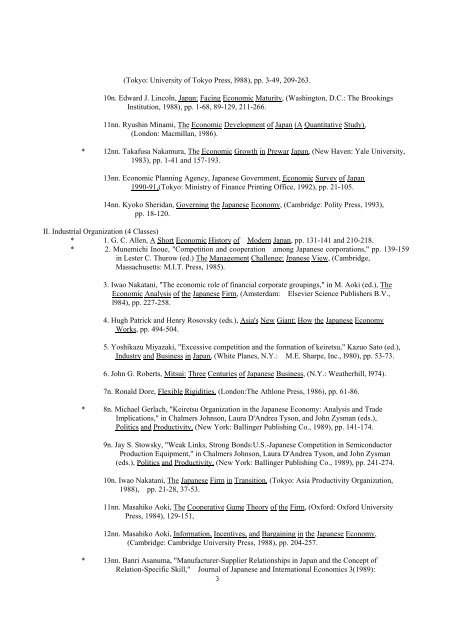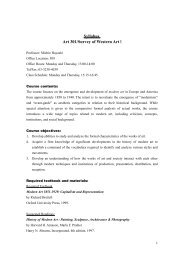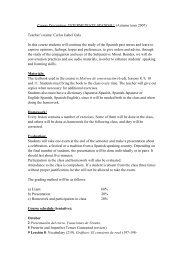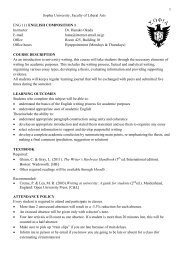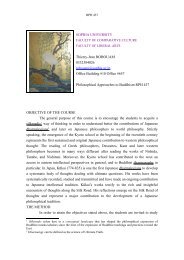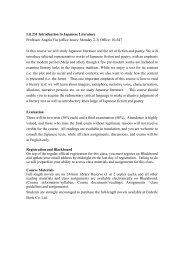1. Paul Stewart, (ed.) - Sophia University Faculty of Liberal Arts
1. Paul Stewart, (ed.) - Sophia University Faculty of Liberal Arts
1. Paul Stewart, (ed.) - Sophia University Faculty of Liberal Arts
You also want an ePaper? Increase the reach of your titles
YUMPU automatically turns print PDFs into web optimized ePapers that Google loves.
(Tokyo: <strong>University</strong> <strong>of</strong> Tokyo Press, l988), pp. 3-49, 209-263.10n. Edward J. Lincoln, Japan: Facing Economic Maturity, (Washington, D.C.: The BrookingsInstitution, 1988), pp. 1-68, 89-129, 211-266.11nn. Ryushin Minami, The Economic Development <strong>of</strong> Japan (A Quantitative Study),(London: Macmillan, 1986).* 12nn. Takafusa Nakamura, The Economic Growth in Prewar Japan, (New Haven: Yale <strong>University</strong>,1983), pp. 1-41 and 157-193.13nn. Economic Planning Agency, Japanese Government, Economic Survey <strong>of</strong> Japan1990-91,(Tokyo: Ministry <strong>of</strong> Finance Printing Office, 1992), pp. 21-105.14nn. Kyoko Sheridan, Governing the Japanese Economy, (Cambridge: Polity Press, 1993),pp. 18-120.II. Industrial Organization (4 Classes)* <strong>1.</strong> G. C. Allen, A Short Economic History <strong>of</strong> Modern Japan, pp. 131-141 and 210-218.* 2. Munemichi Inoue, "Competition and cooperation among Japanese corporations," pp. 139-159in Lester C. Thurow (<strong>ed</strong>.) The Management Challenge: Jpanese View, (Cambridge,Massachusetts: M.I.T. Press, 1985).3. Iwao Nakatani, "The economic role <strong>of</strong> financial corporate groupings," in M. Aoki (<strong>ed</strong>.), TheEconomic Analysis <strong>of</strong> the Japanese Firm, (Amsterdam: Elsevier Science Publishers B.V.,l984), pp. 227-258.4. Hugh Patrick and Henry Rosovsky (<strong>ed</strong>s.), Asia's New Giant: How the Japanese EconomyWorks, pp. 494-504.5. Yoshikazu Miyazaki, "Excessive competition and the formation <strong>of</strong> keiretsu," Kazuo Sato (<strong>ed</strong>.),Industry and Business in Japan, (White Planes, N.Y.: M.E. Sharpe, Inc., l980), pp. 53-73.6. John G. Roberts, Mitsui: Three Centuries <strong>of</strong> Japanese Business, (N.Y.: Weatherhill, l974).7n. Ronald Dore, Flexible Rigidities, (London:The Athlone Press, 1986), pp. 61-86.* 8n. Michael Gerlach, "Keiretsu Organization in the Japanese Economy: Analysis and TradeImplications," in Chalmers Johnson, Laura D'Andrea Tyson, and John Zysman (<strong>ed</strong>s.),Politics and Productivity, (New York: Ballinger Publishing Co., 1989), pp. 141-174.9n. Jay S. Stowsky, "Weak Links, Strong Bonds:U.S.-Japanese Competition in SemiconductorProduction Equipment," in Chalmers Johnson, Laura D'Andrea Tyson, and John Zysman(<strong>ed</strong>s.), Politics and Productivity, (New York: Ballinger Publishing Co., 1989), pp. 241-274.10n. Iwao Nakatani, The Japanese Firm in Transition, (Tokyo: Asia Productivity Organization,1988), pp. 21-28, 37-53.11nn. Masahiko Aoki, The Cooperative Game Theory <strong>of</strong> the Firm, (Oxford: Oxford <strong>University</strong>Press, 1984), 129-151,12nn. Masahiko Aoki, Information, Incentives, and Bargaining in the Japanese Economy,(Cambridge: Cambridge <strong>University</strong> Press, 1988), pp. 204-257.* 13nn. Banri Asanuma, "Manufacturer-Supplier Relationships in Japan and the Concept <strong>of</strong>Relation-Specific Skill," Journal <strong>of</strong> Japanese and International Economics 3(1989):3


